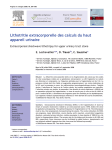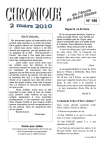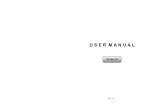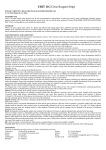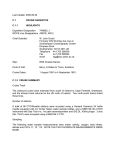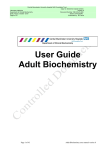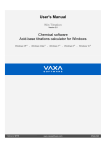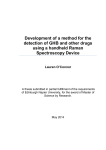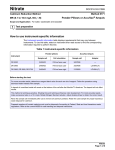Download URICHA - 10 - Robonik India.in
Transcript
Bilirubin: A red azo compound is obtained in presence of acid by coupling of Bilirubin with a diazonium salt. URICHA .... Urine Test strips for Urine Analysis URICHA - 10 (Strips for quantitative determination of Blood, Urobilinogen, Bilirubin, Protein, Nitrite, Ketones, Glucose, pH, Density & Leukocytes) In vitro diagnostic test kit, for professional use only INTENDED USE : Screening test for detection of diabetes, metabolic abnormalities, liver diseases, biliary and hepatic obstructions, hemolytic diseases and diseases of kidney and urinary tract. URICHA 10 Test strips are compatible with URICHA, Urine Chemistry Analyser. ORDERING INFORMATION : Pack Size Cat No. 1 X 100 Test Strips UR10 01 100 6 X 100 Test Strips UR10 06 100 INSTRUCTIONS FOR USE: Dip the test strip for approximately one second into the urine. Draw it across the rim of the container to remove excess urine. Place the test strips onto the instrument URICHA according to instructions for use in the user’s manual. The Test pads are evaluated on Uricha, reflectance meter, the results are displayed & printed out. The results obtained with the Uricha10 and Uricha-10 V correspond to the concentration ranges indicated on the colour chart for visual evaluation. For visual evaluation, please compare colour changes with the colour chart between 30 & 60 seconds (leukocyte test field between 60 & 120 seconds). Colour changes that take place after more than 2 minutes are of no significance. When tested the urine should not be older than 2 hours. Due to the fact, that the human eye evaluates colour changes somewhat differently than a Uricha Reflectance Meter, there can also be differences between these two evaluations. REAGENTS : minimum quantity resp. activity/cm2 at time of expiry Blood: Tetramethylbenzidine 59 µg Cumene Hydroperoxide 253 µg Urobilinogen: Diazonium Salt 28 µg Bilirubin: Diazonium Salt 26 µg Protein: Tetrabromophenol Blue 7.5 µg Nitrite: Sulfanilic Acid Quinoline Derivative Ketones: Sodium Nitroprusside Glucose: Glucose Oxidase Peroxidase o-tolidine pH: 80 µg Methyl Red 25 µg Bromothymol Blue Density: 116µg Bromothymol Blue Copolymer 3.2 U Leukocytes: 0.2 U Carboxylic Acid Ester 65 µg Diazonium Salt 2.8 µg 10 µg 12 µg 295 µg 10.6µg 4.4 µg STORAGE INSTRUCTIONS AND REAGENT STABILITY: Store the container between 15 to 30°C in a dry place. The test strips are stable, when stored properly up to the date of expiry indicated. WASTE MANAGEMENT : Please dispose all used Test Strips in accordance with your local laws and regulations. WARNINGS & PRECAUTIONS : In any case, in order to establish a final diagnosis and prescribe an appropriate therapy, the results obtained with test strips should be correlated with other medical results. The effect of medicaments or their metabolic products on the test is not known in all cases. In case of doubt it is recommended not to take the medicaments and repeat the test. Use well washed and clean containers only for urine collection. The presence of usual urine preservatives will not affect the test results. Remove only as many test strips as required, and reseal the container immediately after use. Do not touch the test pads. Avoid exposing the strips to sunlight and moisture. The cap contains a non-poisonous and harmless desiccant. In case this desiccant is swallowed accidently, then drink plenty of water, seek medical aid. SPECIMEN: Use fresh and uncentrifuged urine. Shake urine sample well before use. PRINCIPLE : Blood: The detection is based on the pseudoperoxidative activity of hemoglobin and myoglobin, which catalyze the oxidation of an indicator by an organic hydroperoxide producing a green colour. Urobilinogen: The test paper contains a stable diazonium salt forming a reddish azo compound with urobilinogen, when present. Protein: The test is based on the “protein error” principle of indicators. The test zone is buffered to a constant pH value and colour changes from yellow to greenish blue in the presence of albumin. Other proteins are indicated with less sensitivity. Nitrite: Microorganisms, which are able to reduce nitrate to nitrite, are indicated indirectly by this test. The principle of Griess reagent is the basis of this test. The test paper contains an amine and a coupling component. A red coloured azo compound is formed by diazotisation and subsequent coupling. Ketones: The test is based on the principle of Legal's test. Acetoacetic acid and acetone form a violet coloured complex with sodium nitroprusside in alkaline medium. Glucose: The detection is based on the glucose oxidase-peroxidasechromogen reaction. Apart from glucose, no other compound in urine is known to give a positive reaction. pH: The test paper contains indicators which clearly change colour between pH 5 and pH 9 (from orange to green to turquoise). Density: The test determines the concentration of ions in urine and shows a good correlation to the refractometric method. The colour of the test strip changes from deep blue in urine with low ionic concentration through green to yellow in urines with high ionic concentrations. Leukocytes: The test is based on the esterase activity of granulocytes. This enzyme splits carboxylic acid esters. The alcohol constituent released reacts with a diazo salt producing a violet colour. PERFORMANCE CHARACTERISTICS : Measuring Range / Specificity / Sensitivity / Interpretation Compensation Area: The compensation test pad is free of any chemicals and is solely used as reference for the reflectance meter evaluation of the other test pads. Blood: The minimum sensitivity of the test strip is 5 to 10 erythrocytes/µl of urine corresponding to approx. 0.015 mg hemoglobin/dl of urine. Intact erythrocytes are indicated by flecky discolourations of the test field. A slight green colouration of the test field is normal, and not an indication of the presence of blood in urine. When the green colouration matches the first positive colour block on the colour scale, then the results are to be determined as positive. The colour fields correspond to the following values: 0 (negative), ca. 5-10, ca. 50, ca. 250 Ery/µl resp. hemoglobin concentration out of ca. 10, ca. 50, ca. 250 Ery/µl Normal concentrations of Ascorbic Acid (< 40 mg/dl) do not influence the test results. Falsely positive reactions can be produced by residue of peroxide containing cleansing agents. Urobilinogen: In dependence upon the urine colour 0.5 to 1 mg urobilinogen/dl urine are indicated. 1 mg/dl is considered to be the normal excretion rate. Higher values are pathological. A complete absence of urobilinogen in the urine, which is likewise pathological, cannot be indicated by the strips. The colour fields correspond to the following urobilinogen concentrations: norm. (normal), 2, 4, 8, 12 mg/dl or norm. (normal), 35, 70, 140, 200 µmol/l. The test will be inhibited by higher concentrations of formaldehyde. Exposure of the urine to light for a longer period of time may lead to lowered or falsely negative results. Too high or falsely positive results can be caused by the presence of diagnostic or therapeutic dyes in the urine. Larger amounts of bilirubin produce a yellow colouration. Bilirubin: The minimum sensitivity of the test strip is 0.5 to 1 mg bilirubin/dl urine. The colour fields correspond to the following values: 0 (negative), 1(+), 2(++), 4(+++) mg/dl or 0 (negative), 17(+), 35(++), 70(+++) µmol/L. Some urine contents can produce a yellow colouration of the test strip. Ascorbic acid and nitrite in higher concentrations inhibit the test. Exposure of the urine to light for a longer period of time may lead to lowered or falsely negative results. Too high or falsely positive results can be caused by the presence of diagnostic or therapeutic dyes in the urine. Protein: The minimum sensitivity of the test strip is 10 mg protein/dl urine. The colour fields correspond to the following ranges of albumin concentrations: Negative, 30, 100 and 500 mg/dl or negative, 0.3, 1.0 and 5.0 g/l Falsely positive results are possible in alkaline urine samples (pH > 9), after infusions with polyvinylpyrrolidone (blood substitute), after intake of medicaments containing quinine and also by disinfectant residues in the urine sampling vessel. The protein colouration may be masked by the presence of medical dyes (e.g. methylene blue) or beetroot pigments. Nitrite: The test detects concentrations from 0.05 to 0.1 mg nitrite/dl urine. Every pink colour indicates a bacterial infection of the urinary tract. The colour intensity depends only on the nitrite concentration, but does not provide information about the extent of the infection. A negative result does not preclude an infection of the urinary tract, if bacteria which cannot produce nitrite are present. Falsely negative results can be produced by high doses of ascorbic acid, by antibiotics therapy and by very low nitrate concentrations in urine as the result of low nitrate diet or strong dilution (diuresis). Falsely positive results can be caused by the presence of diagnostic or therapeutic dyes in the urine. Ketones: The test is more sensitive to acetoacetic acid than to acetone. Values of 10 mg/dl acetoacetic acid or 50 mg/dl acetone are indicated. The colour fields correspond to the following acetoacetic acid values: 0 (negative), 25(+), 100(++) and 300(+++) mg/dl or 0 (negative), 2.5(+), 10(++) and 30(+++) mmol/l Phenylketones in higher concentrations interfere with the test, and will produce variable colours. Β-Hydroxybutyric acid is not detected. Phthalein compounds interfere by producing a red colouration. Glucose: Pathological glucose concentrations are indicated by a colour change from green to bluish green. Yellow or greenish test fields should be considered negative or normal. The colour fields correspond to the following ranges of glucose concentrations: neg. (yellow), neg. or normal (greenish), 50, 150, 500 and ≥ 1000 mg/dl or neg. (yellow), neg. or normal (greenish), 2.8, 8.3, 27.8 and ≥ 55.5 mmol/l. Larger amounts of ascorbic acid which may be present in urine after a high intake of vitamin C (e.g. vitamin tablets, antibiotics or fruit juices) can lead to lower or falsely negative results. In addition an inhibitory effect is produced by gentisic acid. Falsely positive reactions can also be produced by a residue of peroxide containing cleansing agents. Leukocytes: The test records values starting from approx. 10-25 leukocytes/µl urine. Changes in colour that can not be assigned to the negative reference field and faint violet colours of 120 seconds must be evaluated as positive. The colour reference fields correspond to the following leukocyte concentrations: negative (normal), 25, 75, 500 leukocytes/µl A weakened reaction can be expected in the case of proteinuria of over 500 mg/dl and a glucose concentration of over 2 g/dl as well as in the case of patients taking preparations containing cephalexin and gentamycin. Bacteria, Trichomonas and erythrocytes do not interfere with this test. Formaldehyde (as a preservative) can result in a false positive reaction. Excretion of bilirubin, nitrofruantoin or other strongly-coloured compounds may disguise the colour of the reaction. Tests with female patients have shown that vaginal discharge can cause a false positive reaction. QUALITY CONTROL : To ensure adequate quality, use of commercially available urine control is recommended. ROBONIK offers URICHA N & P Control in 2 X 15 ml pack size. BIBLIOGRAPHY : 1. Goldner AP, Mayron R, & Ruiz E: Are urine dipsticks reliable indicators of hematuria in blunt trauma patients. Ann Emerg Med 1985; 14(6) : 580 - 582. 2. Chandhoke PS & McAninch JW : Detection and significance of microscopic hematuria in patients with blunt renal trauma.. J Urol 1988; 140 : 16-18. 3. McPherson RA, Ben-Ezra J, Zhao S. Basic examination of urine. In : McPherson RA, Pinchu MR, eds. Henry’s Clinical Diagnosis and Management by Laboratory Methods. 21st ed. Philadelphia, Pa: Saunders Elsevier; 2006 : chap 27. 4. Naumann HN. Studies on bile pigments : A study of Ehrlich’s test for urobilinogen and Schlesinger’s reaction for urobilin. Biochem J. 1936 Mar, 30 (3):347-351. 5. Yoder, J. Adams, E.C., and Free. H.M.: Simultaneous Screening for Urinary Occult Blood, Protein, Glucose, and pH. Amer. J. Med Tech. 31:285; (1956). 6. Shchersten, B. and Friz, H.: Subnormal Levels of Glucose in Urine. JAMA 201:129-132; (1967). 7. Tietz NW. Taxtbook of Clinical Chemistry W.B. Saunders Company. 1986, 1734. 8. Tsai, S.C. et. al., J. Anal. Toxicol. 1998; 22 (6):474. pH: The pH value of fresh urine of healthy individuals varies between pH 5 and pH 6. The colour scale gives a clear distinction of pH value between pH 5 and pH 9. Density: The test permits the determination of urine density between 1.000 and 1.030. Urines from adults with normal diets and normal fluid intake will have a density of 1.015-1.025. The chemical nature of the test strip may cause slightly different results from those obtained with other methods when elevated amounts of certain urine constituents are present, e.g. the increase of urine density in dependence on glucose concentrations of > 1000 mg/dl (> 56 mmol/l) cannot be demonstrated by the strips. Elevated density readings may be obtained in the presence of moderate quantities of protein. Highly buffered alkaline urines may cause low readings. An ISO 9001 : 2008 Certified Company An ISO 13485 : 2003 Certified Company Manufactured and Marketed by: ROBONIK (INDIA) PVT. LTD., A-374, TTC Industrial Area, Mahape, Navi Mumbai - 400 710, INDIA. Tel. No.: + 91 (22) 67829700 Fax. No.: + 91 (22) 67829701 Orders : [email protected] Queries : [email protected] Website : www.robonik.in SYMBOLS USED ON THE LABELS: IVD For in vitro diagnostic use Exp. Date LOT Lot No. Store at Do Not Reuse Consult Instructions for use Manufacturer’s Address REF Catalogue Number Date of Manufacture Ver.: UR10/0811/00 URICHA - 10 is the Trade Mark of ROBONIK (INDIA) PVT.LTD., for Test Strips - Urine Analysis. URICHA is the Trade Mark of ROBONIK (INDIA) PVT. LTD., for Urine Chemistry Analyser.




